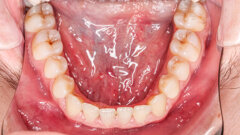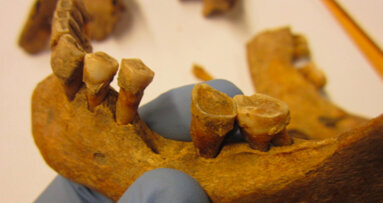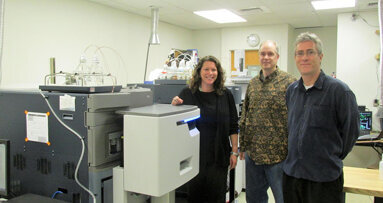COPENHAGEN, Denmark: Though its popularity and constituent ingredients have changed over time, chewing gum has been used by humans for thousands of years. A new study out of Denmark that analysed a 5,700-year-old piece of chewing gum made from birch bark pitch has succeeded in extracting a complete human genome from the pitch, demonstrating its potential as a new source of ancient DNA.
The pitch was found during archaeological excavations carried out by the Museum Lolland-Falster at Syltholm in southern Denmark, and subsequent analysis was conducted by researchers at the University of Copenhagen. Radiocarbon dating of the pitch helped to place it as a specimen from the early Neolithic period in Denmark, while DNA sequencing revealed that it was chewed by a female who was more closely genetically related to the hunter-gatherers of mainland Europe than to those who populated central Scandinavia at the time. It was found that she probably possessed dark skin, dark hair and blue eyes.
Traces of hazelnut and duck DNA were also identified in the pitch, suggesting that these may have formed part of the individual’s diet. The researchers also successfully identified DNA fragments from several bacterial and viral taxa, including the Epstein–Barr virus, which can cause glandular fever.
“[Syltholm] is the biggest Stone Age site in Denmark and the archaeological finds suggest that the people who occupied the site were heavily exploiting wild resources well into the Neolithic, which is the period when farming and domesticated animals were first introduced into southern Scandinavia,” said Dr Theis Jensen, a postdoctoral student at the University of Copenhagen’s Globe Institute and a co-author of the study.
“We managed to extract many different bacterial species that are characteristic of an oral microbiome,” added Dr Hannes Schroeder, associate professor at the Globe Institute.
“Our ancestors lived in a different environment and had a different lifestyle and diet, and it is therefore interesting to find out how this is reflected in their microbiome,” he continued.
Though still a relatively new form of analysis, DNA sequencing from birch bark pitch is growing in popularity, in part owing to its potential to be a good proxy for human bones in archaeogenetic studies. As reported by Dental Tribune International last year, Scandinavian researchers have previously used pitch to sequence DNA from the first humans who settled in the region some 10,000 years ago.
Though a considerable amount of information can be uncovered through the DNA sequencing of pitch, several questions still remain—including the question of what the purpose of chewing it was. Some researchers have suggested that it may have been a method for making the pitch more pliable for further toolmaking purposes, while medicinal and hunger-suppressing uses have also been put forward for consideration.
The study, titled “A 5700 year-old human genome and oral microbiome from chewed birch pitch”, was published on 17 December 2019 in Nature Communications.
Tags:
STOCKHOLM, Sweden: Chewing gum has long been something that many people use. In a recent discovery in Scandinavia, researchers have found that the first ...
COPENHAGEN, Denmark: A number of recent studies have shown that dental calculus from archaeological samples could be a rich source for better understanding ...
LONDON, England: The inextricable relationship between a person’s oral and overall health has the potential to radically transform the dental industry and...
LONDON, UK: Though the relative benefits of chewing gum are often subject to debate, a number of studies have shown that the sugar-free varieties can ...
WASHINGTON, U.S.: The use of tobacco has forever been etched in human history. Now, for the first time, researchers in the U.S. have shown that nicotine ...
BILBAO, Spain: While the systemic health implications of neuropsychiatric disorders are well recognised, their connection to poor oral health—in ...
NEW YORK, US: Oral diseases and depression are both projected to rise in prevalence over the coming decades, and recent findings suggest the two may be ...
BRISBANE, Australia: There is much debate of the pros and cons of breast- and bottle-feeding. A research team from the Queensland University of Technology ...
PENNSYLVANIA, U.S.: It doesn’t take much searching on the Internet to find that chewing gum is a contentious subject. In a recent study that could help ...
RIYADH, Saudi Arabia: Oral cancer constitutes a major front in the global fight against non-communicable diseases, and heightened public awareness of risk ...
Live webinar
Mon. 12 January 2026
9:00 am EST (New York)
Prof. Judith Jones D.D.S; M.P.H., Prof. Kakuhiro Fukai D.D.S., Ph.D, Dr. Bathsheba (Bethy) Turton
Live webinar
Wed. 14 January 2026
12:00 pm EST (New York)
Dr. Théo Laplane, Dr. Robert Gottlander DDS
Live webinar
Fri. 16 January 2026
12:00 pm EST (New York)
Live webinar
Mon. 19 January 2026
1:00 pm EST (New York)
Philipp Kopp, Michael Seeber
Live webinar
Thu. 22 January 2026
2:00 pm EST (New York)
Dr. Nicola M. Grande DDS, PhD
Live webinar
Wed. 28 January 2026
8:00 am EST (New York)
Live webinar
Wed. 28 January 2026
11:00 am EST (New York)
Prof. Dr. Jan-Frederik Güth



 Austria / Österreich
Austria / Österreich
 Bosnia and Herzegovina / Босна и Херцеговина
Bosnia and Herzegovina / Босна и Херцеговина
 Bulgaria / България
Bulgaria / България
 Croatia / Hrvatska
Croatia / Hrvatska
 Czech Republic & Slovakia / Česká republika & Slovensko
Czech Republic & Slovakia / Česká republika & Slovensko
 France / France
France / France
 Germany / Deutschland
Germany / Deutschland
 Greece / ΕΛΛΑΔΑ
Greece / ΕΛΛΑΔΑ
 Hungary / Hungary
Hungary / Hungary
 Italy / Italia
Italy / Italia
 Netherlands / Nederland
Netherlands / Nederland
 Nordic / Nordic
Nordic / Nordic
 Poland / Polska
Poland / Polska
 Portugal / Portugal
Portugal / Portugal
 Romania & Moldova / România & Moldova
Romania & Moldova / România & Moldova
 Slovenia / Slovenija
Slovenia / Slovenija
 Serbia & Montenegro / Србија и Црна Гора
Serbia & Montenegro / Србија и Црна Гора
 Spain / España
Spain / España
 Switzerland / Schweiz
Switzerland / Schweiz
 Turkey / Türkiye
Turkey / Türkiye
 UK & Ireland / UK & Ireland
UK & Ireland / UK & Ireland
 Brazil / Brasil
Brazil / Brasil
 Canada / Canada
Canada / Canada
 Latin America / Latinoamérica
Latin America / Latinoamérica
 USA / USA
USA / USA
 China / 中国
China / 中国
 India / भारत गणराज्य
India / भारत गणराज्य
 Pakistan / Pākistān
Pakistan / Pākistān
 Vietnam / Việt Nam
Vietnam / Việt Nam
 ASEAN / ASEAN
ASEAN / ASEAN
 Israel / מְדִינַת יִשְׂרָאֵל
Israel / מְדִינַת יִשְׂרָאֵל
 Algeria, Morocco & Tunisia / الجزائر والمغرب وتونس
Algeria, Morocco & Tunisia / الجزائر والمغرب وتونس
 Middle East / Middle East
Middle East / Middle East
















































To post a reply please login or register